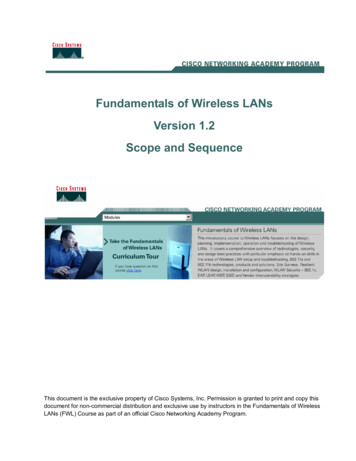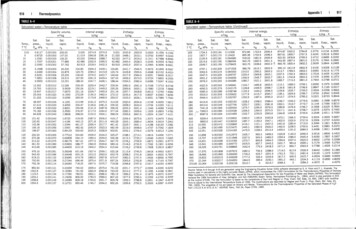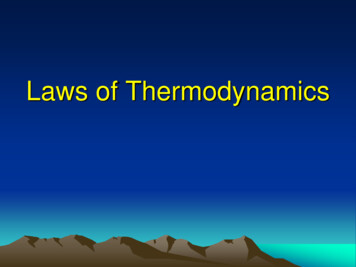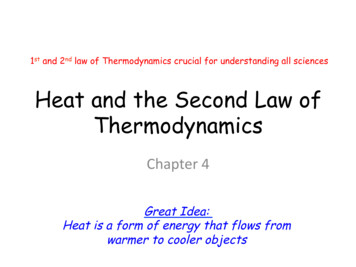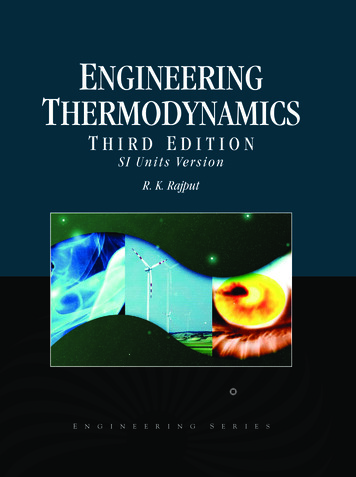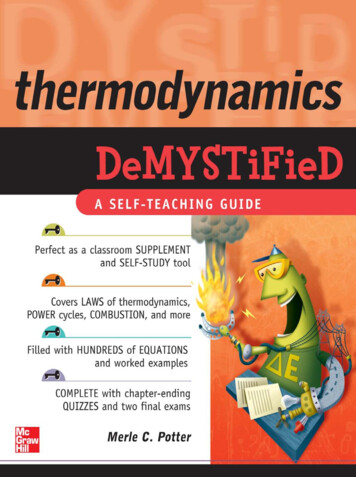
Transcription
ThermodynamicsDemystified
Demystified SeriesAccounting DemystifiedAdvanced Calculus DemystifiedAdvanced Physics DemystifiedAdvanced Statistics DemystifiedAlgebra DemystifiedAlternative Energy DemystifiedAnatomy DemystifiedAstronomy DemystifiedAudio DemystifiedBiochemistry DemystifiedBiology DemystifiedBiotechnology DemystifiedBusiness Calculus DemystifiedBusiness Math DemystifiedBusiness Statistics DemystifiedC DemystifiedCalculus DemystifiedChemistry DemystifiedCircuit Analysis DemystifiedCollege Algebra DemystifiedComplex Variables DemystifiedCorporate Finance DemystifiedDatabases DemystifiedDiabetes DemystifiedDifferential Equations DemystifiedDigital Electronics DemystifiedDiscrete Mathematics DemystifiedDosage Calculations DemystifiedEarth Science DemystifiedElectricity DemystifiedElectronics DemystifiedEngineering Statistics DemystifiedEnvironmental Science DemystifiedEveryday Math DemystifiedFertility DemystifiedFinancial Planning DemystifiedFluid Mechanics DemystifiedForensics DemystifiedFrench DemystifiedGenetics DemystifiedGeometry DemystifiedGerman DemystifiedGlobal Warming and Climate Change DemystifiedHedge Funds DemystifiedInvesting DemystifiedItalian DemystifiedJava DemystifiedJavaScript DemystifiedLean Six Sigma DemystifiedLinear Algebra DemystifiedMacroeconomics DemystifiedManagement Accounting DemystifiedMath Proofs DemystifiedMath Word Problems DemystifiedMathematica DemystifiedMATLAB DemystifiedMedical Billing and Coding DemystifiedMedical Charting DemystifiedMedical-Surgical Nursing DemystifiedMedical Terminology DemystifiedMeteorology DemystifiedMicrobiology DemystifiedMicroeconomics DemystifiedNanotechnology DemystifiedNurse Management DemystifiedOOP DemystifiedOptions DemystifiedOrganic Chemistry DemystifiedPharmacology DemystifiedPhysics DemystifiedPhysiology DemystifiedPre-Algebra DemystifiedPrecalculus DemystifiedProbability DemystifiedProject Management DemystifiedPsychology DemystifiedQuantum Field Theory DemystifiedQuantum Mechanics DemystifiedReal Estate Math DemystifiedRelativity DemystifiedRobotics DemystifiedSales Management DemystifiedSignals and Systems DemystifiedSix Sigma DemystifiedSpanish DemystifiedSQL DemystifiedStatics and Dynamics DemystifiedStatistics DemystifiedString Theory DemystifiedTechnical Analysis DemystifiedTechnical Math DemystifiedThermodynamics DemystifiedTrigonometry DemystifiedVitamins and Minerals Demystified
ThermodynamicsDemystifiedMerle C. Potter, Ph.D.New York Chicago San Francisco Lisbon LondonMadrid Mexico City Milan New Delhi San JuanSeoul Singapore Sydney Toronto
Copyright 2009 by The McGraw-Hill Companies, Inc. All rights reserved. Except as permitted under the United States CopyrightAct of 1976, no part of this publication may be reproduced or distributed in any form or by any means, or stored in a database orretrieval system, without the prior written permission of the publisher.ISBN: 978-0-07-160600-4MHID: 0-07-160600-9The material in this eBook also appears in the print version of this title: ISBN: 978-0-07-160599-1, MHID: 0-07-160599-1.All trademarks are trademarks of their respective owners. Rather than put a trademark symbol after every occurrence of atrademarked name, we use names in an editorial fashion only, and to the benefit of the trademark owner, with no intention ofinfringement of the trademark. Where such designations appear in this book, they have been printed with initial caps.McGraw-Hill eBooks are available at special quantity discounts to use as premiums and sales promotions, or for use in corporatetraining programs. To contact a representative please visit the Contact Us page at www.mhprofessional.com.Information contained in this work has been obtained by The McGraw-Hill Companies, Inc. (“McGraw-Hill”) from sources believedto be reliable. However, neither McGraw-Hill nor its authors guarantee the accuracy or completeness of any information publishedherein, and neither McGraw-Hill nor its authors shall be responsible for any errors, omissions, or damages arising out of use of thisinformation. This work is published with the understanding that McGraw-Hill and its authors are supplying information but are notattempting to render engineering or other professional services. If such services are required, the assistance of an appropriateprofessional should be sought.TERMS OF USEThis is a copyrighted work and The McGraw-Hill Companies, Inc. (“McGraw-Hill”) and its licensors reserve all rights in and to thework. Use of this work is subject to these terms. Except as permitted under the Copyright Act of 1976 and the right to store andretrieve one copy of the work, you may not decompile, disassemble, reverse engineer, reproduce, modify, create derivative worksbased upon, transmit, distribute, disseminate, sell, publish or sublicense the work or any part of it without McGraw-Hill’s prior consent. You may use the work for your own noncommercial and personal use; any other use of the work is strictly prohibited. Yourright to use the work may be terminated if you fail to comply with these terms.THE WORK IS PROVIDED “AS IS.” McGRAW-HILL AND ITS LICENSORS MAKE NO GUARANTEES OR WARRANTIESAS TO THE ACCURACY, ADEQUACY OR COMPLETENESS OF OR RESULTS TO BE OBTAINED FROM USING THEWORK, INCLUDING ANY INFORMATION THAT CAN BE ACCESSED THROUGH THE WORK VIA HYPERLINK OROTHERWISE, AND EXPRESSLY DISCLAIM ANY WARRANTY, EXPRESS OR IMPLIED, INCLUDING BUT NOT LIMITED TO IMPLIED WARRANTIES OF MERCHANTABILITY OR FITNESS FOR A PARTICULAR PURPOSE. McGraw-Hill andits licensors do not warrant or guarantee that the functions contained in the work will meet your requirements or that its operationwill be uninterrupted or error free. Neither McGraw-Hill nor its licensors shall be liable to you or anyone else for any inaccuracy,error or omission, regardless of cause, in the work or for any damages resulting therefrom. McGraw-Hill has no responsibility forthe content of any information accessed through the work. Under no circumstances shall McGraw-Hill and/or its licensors be liablefor any indirect, incidental, special, punitive, consequential or similar damages that result from the use of or inability to use thework, even if any of them has been advised of the possibility of such damages. This limitation of liability shall apply to any claimor cause whatsoever whether such claim or cause arises in contract, tort or otherwise.
ABOUT THE AUTHORMerle C. Potter, Ph.D., has engineering degrees from Michigan TechnologicalUniversity and the University of Michigan. He has coauthored Fluid Mechanics,Mechanics of Fluids, Thermodynamics for Engineers, Thermal Sciences, DifferentialEquations, Advanced Engineering Mathematics, and Jump Start the HP-48G inaddition to numerous exam review books. His research involved fluid flow stabilityand energy-related topics. The American Society of Mechanical Engineers awardedhim the 2008 James Harry Potter Gold Medal. He is Professor Emeritus of MechanicalEngineering at Michigan State University and continues to write and golf.
This page intentionally left blank
CONTENTSCHAPTER 1CHAPTER 2PrefacexiBasic Principles1.1 The System and Control Volume1.2 Macroscopic Description1.3 Properties and State of a System1.4 Equilibrium, Processes, and Cycles1.5 Units1.6 Density, Specific Volume, andSpecific Weight1.7 Pressure1.8 Temperature1.9 EnergyQuiz No. 1Quiz No. 2123457101114151719Properties of Pure Substances2.1 The P-v-T Surface2.2 The Liquid-Vapor Region2.3 The Steam Tables2.4 Equations of State2.5 Equations of State for a Nonideal GasQuiz No. 1Quiz No. 22323262730333537
viiiThermodynamics DemystifiedCHAPTER 3Work and Heat3.1 Work3.2 Work Due to a Moving Boundary3.3 Nonequilibrium Work3.4 Other Work Modes3.5 Heat TransferQuiz No. 1Quiz No. 24141434849525457CHAPTER 4The First Law of Thermodynamics4.1 The First Law Applied to a Cycle4.2 The First Law Applied to a Process4.3 Enthalpy4.4 Latent Heat4.5 Specific Heats4.6 The First Law Applied to VariousProcesses4.7 The First Law Applied to ControlVolumes4.8 Applications of the Energy EquationQuiz No. 1Quiz No. 2616163666768CHAPTER 5The Second Law of Thermodynamics5.1 Heat Engines, Heat Pumps, andRefrigerators5.2 Statements of the Second Law5.3 Reversibility5.4 The Carnot Engine5.5 Carnot Efficiency5.6 Entropy5.7 The Inequality of Clausius5.8 Entropy Change for an Irreversible Process5.9 The Second Law Applied to aControl Volume7278818994101102103105107110113123124128
ixContentsQuiz No. 1Quiz No. 2133137CHAPTER 6Power and Refrigeration Vapor Cycles6.1 The Rankine Cycle6.2 Rankine Cycle Efficiency6.3 The Reheat Cycle6.4 The Regenerative Cycle6.5 Effect of Losses on Power Cycle Efficiency6.6 The Vapor Refrigeration Cycle6.7 The Heat PumpQuiz No. 1Quiz No. 2143144147151153157160164167169CHAPTER 7Power and Refrigeration Gas Cycles7.1 The Air-Standard Cycle7.2 The Carnot Cycle7.3 The Otto Cycle7.4 The Diesel Cycle7.5 The Brayton Cycle7.6 The Regenerative Brayton Cycle7.7 The Combined Cycle7.8 The Gas Refrigeration CycleQuiz No. 1Quiz No. 2173174177177180184188191194198201CHAPTER 8Psychrometrics8.1 Gas-Vapor Mixtures8.2 Adiabatic Saturation and Wet-BulbTemperatures8.3 The Psychrometric Chart8.4 Air-Conditioning ProcessesQuiz No. 1Quiz No. 2205205210213214220223
xCHAPTER 9Thermodynamics DemystifiedCombustion9.1 Combustion Equations9.2 Enthalpy of Formation, Enthalpy ofCombustion, and the First Law9.3 Adiabatic Flame TemperatureQuiz No. 1Quiz No. 2227227APPENDIX AConversion of Units245APPENDIX BMaterial Properties247APPENDIX CSteam Tables253APPENDIX DR134a263APPENDIX EIdeal-Gas Tables269APPENDIX FPsychrometric Chart277APPENDIX GCompressibility Chart279Final Exams281Solutions to Quizzes and Final Exams297Index335233238241243
PREFACEThis book is intended to accompany a text used in the first course in thermodynamicsthat is required in all mechanical engineering departments, as well as several otherdepartments. It provides a succinct presentation of the material so that the studentsmore easily understand the more difficult concepts. Many thermodynamics textsare over 900 pages long and it is often difficult to ferret out the essentials due to theexcessive verbiage. This book presents those essentials.The basic principles upon which a study of thermodynamics is based areillustrated with numerous examples and practice exams, with solutions, that allowstudents to develop their problem-solving skills. All examples and problems arepresented using SI metric units. English-unit equivalents are given in App. A.The mathematics required to solve the problems is that used in several otherengineering courses. The more-advanced mathematics is typically not used in anintroductory course in thermodynamics. Calculus is more than sufficient.The quizzes at the end of each chapter contain four-part, multiple-choiceproblems similar in format to those found in national exams, such as the Fundamentalsof Engineering exam (the first of two exams required in the engineering registrationprocess), the Graduate Record Exam (required when applying for most graduateschools), and the LSAT and MCAT exams. Engineering courses do not, in general,utilize multiple-choice exams but it is quite important that students gain experiencein taking such exams. This book allows that experience. If one correctly answers50 percent or more of multiple-choice questions correctly, that is quite good.If you have comments, suggestions, or corrections or simply want to opine,please email me at MerleCP@sbcglobal.net. It is impossible to write a book free oferrors, but if I’m made aware of them, I can have them corrected in futureprintings.Merle C. Potter, Ph.D.
This page intentionally left blank
ThermodynamicsDemystified
This page intentionally left blank
CHAPTER 1Basic PrinciplesThermodynamics involves the storage, transformation, and transfer of energy.Energy is stored as internal energy (due to temperature), kinetic energy (due tomotion), potential energy (due to elevation), and chemical energy (due to chemicalcomposition); it is transformed from one of these forms to another; and it is transferred across a boundary as either heat or work. We will present equations thatrelate the transformations and transfers of energy to properties such as temperature,pressure, and density. The properties of materials thus become very important.Many equations will be based on experimental observations that have been presented as mathematical statements, or laws: primarily the first and second laws ofthermodynamics.The mechanical engineer’s objective in studying thermodynamics is most oftenthe analysis of a rather complicated device, such as an air conditioner, an engine, ora power plant. As the fluid flows through such a device, it is assumed to be a continuum in which there are measurable quantities such as pressure, temperature, andvelocity. This book, then, will be restricted to macroscopic or engineering thermodynamics. If the behavior of individual molecules is important, statistical thermodynamics must be consulted.
Thermodynamics Demystified21.1 The System and Control VolumeA thermodynamic system is a fixed quantity of matter upon which attention isfocused. The system surface is one like that surrounding the gas in the cylinder ofFig. 1.1; it may also be an imagined boundary like the deforming boundary of acertain amount of water as it flows through a pump. In Fig. 1.1 the system is thecompressed gas, the working fluid, and the dashed line shows the system boundary.All matter and space external to a system is its surroundings. Thermodynamicsis concerned with the interactions of a system and its surroundings, or one systeminteracting with another. A system interacts with its surroundings by transferringenergy across its boundary. No material crosses the boundary of a system. If thesystem does not exchange energy with the surroundings, it is an isolated system.An analysis can often be simplified if attention is focused on a part
ABOUT THE AUTHOR Merle C. Potter, Ph.D., has engineering degrees from Michigan Technological University and the University of Michigan. He has coauthored Fluid Mechanics, Mechanics of Fluids, Thermodynamics for Engineers, Thermal Sciences, Differential Equations, Advanced Engineering Mathematics, and Jump Start the HP-48G in addition to numerous exam review books.
